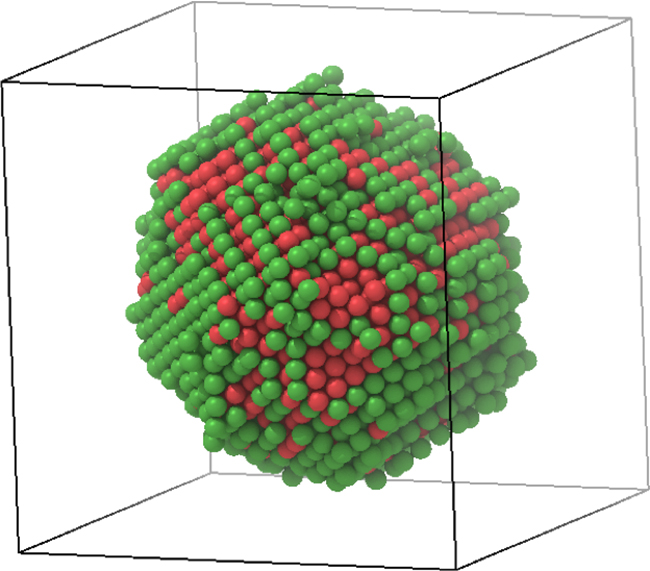MATERIALS SCIENCE AND CHEMISTRY
Computer Simulations of Nucleation Processes in Colloidal Crystals
Principal Investigator:
Kurt Binder and Peter Virnau
Affiliation:
Johannes Gutenberg University, Mainz (Germany)
Local Project ID:
colloid
HPC Platform used:
Hornet and Hazel Hen of HLRS
Date published:
A team from the physics department of the Johannes Gutenberg University, Mainz, has investigated nucleation processes and interfacial properties of colloidal crystals. Nucleation is omnipresent in our daily life and describes events as diverse as the formation of rain in clouds, the crystallization of proteins or the growth of nano-particles. The studies undertaken using supercomputers Hazel Hen and Hornet of HLRS Stuttgart contribute towards a more fundamental understanding of these processes and the underlying theoretical foundation.
Computer simulations play an ever-increasing role in the description and development of novel materials. Even though significant progress has been achieved in computer technology, simulations in statistical physics are still typically limited to a few 100000 particles, which is orders of magnitudes smaller than accessible experiments on the atomistic scale. This fundamental problem was approached from two sides: On the one hand, the group from the University of Mainz has focused on so-called colloidal systems consisting of polymer or silica beads, which are still large enough to be visible and trackable with special optical microscopes, but at the same time, share many features of atomic systems. On the other hand, they have developed novel simulation technologies, which allow them to obtain material properties and properties of interfaces from computer simulations. Even though the systems under investigation are still very small from an experimental point of view, they require supercomputers, such as Hazel Hen at the HLRS Stuttgart, to run effectively.
When a crystal nucleus is surrounded by coexisting fluid in a finite volume in thermal equilibrium, the thermodynamic properties of the fluid (density, pressure, chemical potential) are uniquely related to the surface excess free energy of the nucleus. Using a model for attractive soft colloidal particles, it was shown that this surface excess free energy can be determined accurately from Monte Carlo simulations over a wide range of nucleus volumes, and the resulting nucleation barriers, i.e. the barriers which need to be overcome for nucleation to start, are completely independent from the size of the total volume of the system.

Fig.1: Crystalline nucleus as obtained from a Monte Carlo simulation at packing fraction 0.48 and reservoir packing fraction 0.2. From [2].
Copyright: JGU MainzComputing the solid-liquid interface excess free energy via a newly developed algorithm, the so-called ensemble switch method, a detailed test of Classical Nucleation Theory could be undertaken. For crystallites this theory, which typically assumes spherical nuclei, is hampered by the problem that the nucleus in general is non-spherical (see Fig.1), since the interfacial excess free energy depends on the orientation of the interface relative to the crystal axes. This problem can be avoided in simulations by analyzing the equilibrium of a crystal nucleus surrounded by fluid in a small simulation box in thermal equilibrium. Estimating the fluid pressure and the chemical potential, as well as the volume of the nucleus, suffices to obtain the nucleation barrier without prior knowledge of the crystal shape if properties of the pure phases are known.
In the limit of large crystallites, simulations were shown to be consistent with classical nucleation theory for weekly attractive colloids, while significant deviations occur with increasing attraction and corresponding emergence of strongly facetted nuclei.
Project reports:
1. Monte Carlo simulation of crystal-liquid phase coexistence, A. Statt, F. Schmitz, P. Virnau, K. Binder, W.E. Nagel et al (eds.) High Peformance Computing in Science and Engineering ’15, 75 (2015). DOI 10.1007/978-3-319-24633-8_5.
2. Estimation of nucleation barriers from simulations of crystal nuclei surrounded by fluid in equilibrium, A. Statt, P. Koß, P. Virnau, K. Binder, W.E. Nagel et al (eds.) High Performance Computing in Science and Engineering ’16, (2016). DOI 10.1007/978-3-319-47066-5_4.
3. Surface excess free energy of crystals coexisting with surrounding vapor from large-scale Monte Carlo simulations, Peter Koß, Antonia Statt, P. Virnau, K. Binder, W.E. Nagel et al (eds.) High Performance Computing in Science and Engineering ’17, (2017) submitted.
Scientific Contact
Peter Virnau
KOMET 331
Institute of Physics
Johannes Gutenberg Universität Mainz
D-55099 Mainz (Germany)
e-mail: virnau[at]uni-mainz.de
July 2017